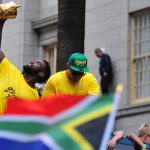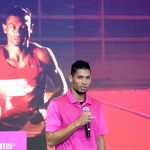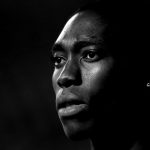ASA and athletes view Doha disaster differently
Wanted: A single hymn sheet from which Athletics South Africa and its athletes can sing to improve their medal haul at the upcoming Olympics in Tokyo.
Author:
6 January 2020

The Springboks’ Rugby World Cup win could be blamed for helping paper over the cracks of the other sporting codes’ collective inadequacies.
With each win in Japan, the subsequent overall victory and the celebrations that one isn’t entirely sure are over, Rassie Erasmus’ men so captivated the South African public that new lows by sports such as cricket and athletics, among others, could fly under the radar.
While the rot in cricket has thankfully come to light, Athletics South Africa (ASA) has almost managed to hide in plain sight the fact that their team went to the World Championships in Qatar and did not declare any precious metal as they snuck back into the country at OR Tambo airport, after finishing third overall at the previous champs – their best performance in the championships to date.
The six medals – three golds, one silver and two bronze – they won in London in 2017 constituted the best the country had done since being readmitted to international athletics events before the Olympics in Barcelona in 1992.
Related article:
Given that athletics contributed four of South Africa’s 10 medals at the Rio Olympics in 2016 – a gold each by Caster Semenya and Wayde van Niekerk, and a silver medal each by Luvo Manyonga and Sunette Viljoen – the average South African would have expected ASA to build on these recent showings.
But they couldn’t muster a single medal in Doha. With this year’s Tokyo Olympics on the horizon, this has left a collective scratching of heads as to the reasons for such a dramatic tailing off in performance. And whether we should prepare for another 2008-type Olympics, in which long jumper Khotso Mokoena’s silver was the lone medal in the country’s worst ever effort at the quadrennial event.
Related article:
Depending on who you speak to, blame for the failure to build on the foundation laid by the Rio Olympics and the London world championships lies either with the athletes or with ASA. The perception of an athlete such as sprinter Akani Simbine’s performance in Doha probably explains it best.
The 100m Commonwealth Games champion, whose personal best of 9.89 seconds for the event also makes him the national record holder, finished fourth in Doha. His season’s best time of 9.93 seconds was the nearest thing to a sprinting medal for Team South Africa.
After finishing fifth in Rio and fourth in London a year later, the serial sub-10 sprinter – who has victories over former world champions Justin Gatlin and Yohan Blake on his CV – must be gatvol of finishing outside the podium circle at major events.
Simbine’s recurring nightmare
But having ASA president Aleck Skhosana use his performances as a case in point of athletes letting the side down must be galling. “Simbine had beaten [Andre] De Grasse, Gatlin, all the Jamaican, English and French boys during the season. The only person standing between him and a gold medal was [eventual champion] Christian Coleman.
“But on the day of the final … you’ll have to ask him what went wrong in the final, because he ran a 9.93 and he should have gone faster than that. He’s the only one who can tell us what happened during that 10 seconds in the final,” said Skhosana.
The disconnect between the ASA and its athletes was highlighted by the reaction of Simbine’s coach, Werner Prinsloo, to the same result. No doubt disappointed, Prinsloo couldn’t go against the fact that his athlete had equalled his best time of the year in the 100m final in Doha.
“When the final came, I said to him, ‘Just enjoy the moment and run for the medal’,” said Prinsloo. “Unfortunately, we didn’t get the medal. Hindsight is always 20/20, you always think you could have done this or that. But the fact is you can only do what you can.
“I can’t say I could have done this or that differently, it’s just that we had to do what we had to do at the time. I told him he didn’t do anything wrong in the final. He had a good race and ran a time which was a season’s best when he needed to. It’s a sign that the preparation worked, but on the day that season’s best wasn’t good enough.”
A difference in approach
This difference in approach – and analysis after the fact – between the athletes and the ASA is a recurring theme in the resultant whodunit about Team South Africa’s abysmal showing in Doha. Looking at something as simple as how many medals they expected is a source of debate. Where Prinsloo and Simbine wanted a medal, any medal, to underpin their gradual progress, the ASA were none the wiser about their medal chances.
“It’s not our policy to say how many medals we’re going to win. We don’t count our chickens before they hatch,” said Skhosana. “Only the Sascoc president [Gideon Sam] does that. We went with a hope that we’d be able to win medals. We asked the Americans and the Jamaicans who they thought was going to win medals in their teams and they said they didn’t know.”
Having chosen the hopeful path, the fact that Skhosana added “when I look back, we should have won five to six medals” probably still rankles his athletes.
But the more important point of departure in getting to the bottom of what happened at the world champs is to look at the identity of the athletes that were integral to the medals won in Brazil and London.
An overreliance on certain athletes
From both events, the names Semenya (two golds from Rio and London in the 800m and world championship bronze in the 1 500m), Van Niekerk (gold in Rio and London in the 400m and 200m silver in the world champs) and Manyonga (Olympic silver and world champs gold in the long jump) are writ large on the medals’ table.
If anything, Semenya and Van Niekerk getting secondary medals from doubling up at the world championships meant they had won two-thirds of the haul in London. So when they were unavailable to compete in Doha – Semenya because of eligibility issues with World Athletics (formerly the IAAF) and Van Niekerk because of his injury – it raised the question whether the ASA relies too much on them.
Related article:
“Wayde and Caster are household names,” said Prinsloo. “Their absence did have an effect because you don’t have the stars. We need other stars to come through, but I think the federation relies on one or two individuals too much to carry the flag and build on their performances.
“If you look at London, four of the six medals came from two athletes, so it’s a bit unbalanced.”
Predictably, Skhosana doesn’t see it the same way. “I wouldn’t say so. Those two were like any other athlete and throughout the time they’ve been winning medals anything could have happened. So we rely on all our athletes because medals come when you least expect them.”
So much for the sprint nation
The happy-go-lucky approach to getting medals is at odds with the narrative from three years ago, when South Africa was the next sprinting powerhouse in the world. Given what Van Niekerk, Anaso Jobodwana and Simbine have done over the years, one has to ask if that momentum has been squandered somewhat.
“It was a good period of performance for us but it wasn’t a national performance, it was more an individual thing,” said Prinsloo. “They [the ASA] sort of jumped on the bandwagon instead of developing it, using the momentum and putting support behind other athletes that want to get into that performance realm. Instead, they were just riding it.
Related article:
“In 2015, everyone was talking about how we’re a sprint nation because we’ve got all these juniors and sprinters winning medals. All that has fallen completely flat, we’re not that anymore. Maybe we haven’t fallen flat, but we can’t say we are a sprinting nation. We are far from it, we’ve got a very small group of sprinting athletes like Akani, Wayde, Anaso and, to an extent, Clarence [Munyai].”
At a structural level, the same issues are still there. Athletes and their coaches continue to complain about national champs being held too early, qualifying standards being too stringent and getting “minimal” support from the federation.
Structural issues
The 2019 senior national championships were held in an unseasonably cold and wet Germiston in March, which necessitated the athletes peaking twice during the year. The stricter qualifying times mean taking smaller teams bereft of youngsters to pick up experience from competing at that level. And the general refrain from the athletes is that they’re achieving what they are in spite of the ASA.
Skhosana said they are already considering holding the national champs in Durban permanently, where the climate means they can be held as late as May or June. But the “double” standards – World Athletics has qualifying metrics that differ from those set by the ASA – are apparently here to stay.
As for the ASA barely supporting the athletes’ ventures on the international circuit, Skhosana was keen to remind his constituents where the current administration picked up athletics (at the time, ASA funds were being spent on lawsuits between administrators) and its appointment of ex-400m runner Paul Gorries to co-ordinate the potential-laden sprint relays as a sign that the federation was not resting on its laurels.
No ‘I’ in team?
Prinsloo was at pains to point out the elephant in the room in athletics, which is that because athletes compete and therefore earn their money as individuals, it is tough to emerge with any tangible idea of a Team South Africa.
To underline how at loggerheads the thinking is, Skhosana actively encourages the athletes to eschew the money-spinning Diamond League meets in favour of doing well for their country later in the season at the major champs.
But there’s no answer as to who’s going to replace the appearance fees they would be earning competing against the best in the world.
What about Tokyo?
The one issue bigger than both the athletes and the ASA is if they should be worried about winning no medals at a world championships event the year before the Olympics. Skhosana and Prinsloo say they aren’t concerned, but for different reasons.
“I’m not worried,” was Skhosana’s typically ebullient answer. “It’s only cowards who get worried. There must be dips, steeps and slopes as you walk, and this year was one such year. The athletes want to achieve, Simbine wants to get a major championship medal and time is running out for him … All the athletes want medals, nobody just wants to visit Tokyo.”
Prinsloo suggested that Skhosana should subscribe to a bit of cowardice: “The federation should be worried, not me. I know what I have to do, I know what Akani needs to do. Maybe the federation have something to worry about in the form of how are they going to build a team of athletes that can contend for medals.”
If the two parties’ views on what constitutes a team are anything to go by, the athletics contingent of Team South Africa should make for an interesting combination.




